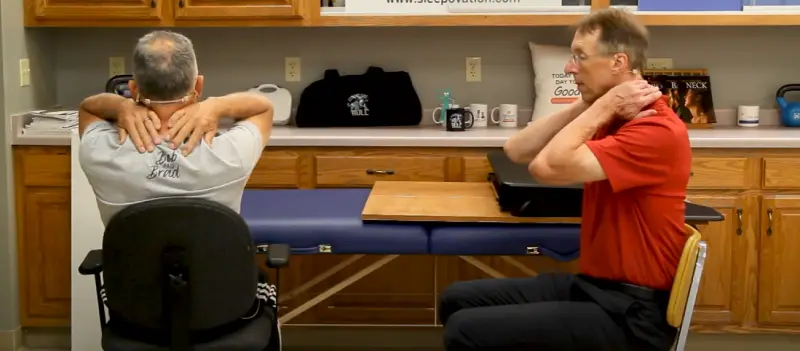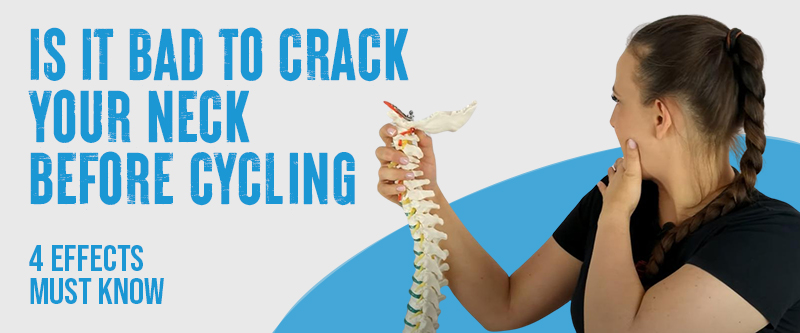Cracking your neck is generally painless and not a cause for concern. Crepitus can arise from changes in movements of ligaments or tendons near bones, grinding in arthritic joints, or the release of gas bubbles in joints.
Cycling with a cracked neck is not recommended, as it may lead to risks such as joint instability, nerve damage, and blood vessel injury. While it might provide momentary relief, the potential harm outweighs the benefits. Refrain from this practice to avert any adverse outcomes.
This article will explain the 4 effects of cracking your neck before cycling, using an expert cyclist’s opinion. Also, provide some safe alternative options to neck cracking before cycling.
Is It Bad To Crack Your Neck Before Cycling: 3 Injury Risks

Cracking your neck before engaging in physical activities like cycling may seem harmless, but it’s important to understand the potential consequences. To ensure a safe and injury-free cycling experience, it is best not to crack your neck before hopping on your bike.
The Physiological Process
When you crack your neck, you are causing the gas bubbles in the joint fluid to burst. Here’s a simple breakdown of what happens:
- Joint Movement: As you move or twist your neck, the pressure inside the joint changes.
- Gas Release: This change in pressure releases nitrogen gas trapped in the joint fluid, creating that familiar popping sound.
- Temporary Relief: The release of gas can often feel like it relieves tension or stiffness in your neck.
Immediate Effects and Sensations for Cyclists
Cyclists might crack their necks to feel more comfortable before riding. Here are some immediate effects and sensations they might experience:
- Sensation of Relief: Many cyclists feel immediate relief and relaxation in their neck muscles.
- Improved Mobility: It might temporarily improve the range of motion, making it easier to turn the head and look around while cycling.
- Endorphin Release: Cracking your neck can release endorphins, chemicals in the brain that make you feel good and reduce pain.
Potential Impact on Overall Cycling Performance
Cracking your neck before cycling might seem like a quick fix to relieve tension, but it can have several impacts on your performance:
- Posture: Frequent neck cracking can sometimes lead to misalignment in your neck and spine. This can affect your posture, making maintaining a proper cycling position harder.
- Balance: Poor neck alignment can also throw off your balance, making it more difficult to control the bike, especially on uneven terrain or sharp turns.
- Overall Performance: When your neck isn’t correctly aligned, it can cause strain on other parts of your body, such as your shoulders and upper back. As a result, you may become fatigued and reduce your overall cycling efficiency.
Long-Term Consequences of Habitual Neck Cracking for Avid Cyclists
For cyclists who frequently crack their necks, there are some potential long-term consequences to be aware of:
- Joint Wear and Tear: Regularly cracking your neck can lead to joint wear and tear. Over time, this can cause more serious issues, such as arthritis.
- Ligament Damage: Constantly manipulating your neck can stretch the ligaments, weaken them, and make you more prone to injuries.
- Chronic Pain: The more you crack your neck, the more likely you will experience chronic neck pain. This can make it challenging to continue cycling at your desired level.
- Pinched Nerves: Cracking your neck can sometimes pinch the nerves in your neck. This can cause sharp pain and make it hard to move your neck.
Cycling Neck Cracking: Expert Opinions

Gently cracking your neck or doing so occasionally poses no harm. Yet, incorrect, frequent, or forceful cracking can lead to increased pain or discomfort. Joint cracking is a prevalent habit.
Medical Professionals’ Perspectives on Neck Cracking Before Cycling
Medical experts have weighed in on the habit of neck cracking before cycling. Here are some key points from their insights:
- Potential Harm: Doctors often warn against frequent neck cracking. They point out that it can lead to joint damage and other neck problems over time.
- Short-Term Relief vs. Long-Term Damage: While neck cracking might give short-term relief, it doesn’t address underlying problems like muscle tension.
Differentiating Between Safe and Harmful Neck Cracking for Cyclists
Neck cracking is not always harmful, but it’s important to know what’s safe and what’s not:
Safe Practices:
- Occasional Cracking: If neck cracking happens occasionally and without force, it’s generally considered safe.
- Gentle Movements: Light stretching and gentle movements can help relieve neck tension without causing harm.
Harmful Practices:
- Frequent Cracking: Constantly cracking your neck can wear down the joints and lead to chronic pain.
- Forceful Manipulation: Using too much force when cracking your neck can strain or injure the muscles and ligaments.
Neck Cracking Before Cycling: Safe Alternatives
Over time, cyclists may experience stiffness and pain in the upper trapezius and neck muscles. The cervicothoracic or C/T junction is a significant area of discomfort besides muscular stiffness.
Recommended Stretching Exercises to Alleviate Neck Stiffness
Instead of cracking your neck, try these gentle stretching exercises to ease stiffness:
- Neck Tilts: As you tilt your head from side to side, aim to bring your ear closer to your shoulder. Each tilt should be held for a few seconds.
- Neck Rotations: Gently turn your head to the right and left as comfortably as possible. Repeat several times.
- Chin Tucks: Stand or sit upright, bring your chin towards your chest, and hold a few seconds before releasing.
Cycling-Friendly Warm-Up Routines

Warming up your neck muscles can help prepare you for a ride without needing to crack your neck:
- Shoulder Shrugs: Tilt your shoulders toward your ears and then release them back down. Repeat 10 times.
- Arm Circles: Move your arms out of your body and make small circles, enlarging the circles as you go. Do this for about 30 seconds in each direction.
- Neck Rolls: Rotate your head slowly, clockwise and counterclockwise. This helps loosen the muscles and improves flexibility.
Conclusion
Cracked neck cycling is a practice with mixed reviews. While it may offer immediate relief, the potential impact on our posture, balance, and overall cycling performance should be noticed.
Considering the potential long-term consequences, it’s clear that this area requires more careful consideration from every cyclist.
Instead of relying on neck cracking for relief, incorporating recommended stretching exercises and effective warm-up routines could provide similar relief. So, is it harmful for your neck to crack before cycling? Based on the evidence, it might be wise to explore other options.
FAQs
Cracking Your Fingers During Cycling Is Bad?
Cracking your fingers while cycling is not recommended, as it can lead to ligament injuries or dislocation. Avoiding this habit to prevent potential harm and maintain proper hand function while cycling is best.
What Is The Average Duration Of A Neck Crack?
An unmistakable indicator that a neck crack is due to crepitus is to repeat the motion that caused it and check if it happens again. If it doesn’t, the crack was likely due to crepitus—it takes about 20 minutes for the gas bubbles to redevelop.


